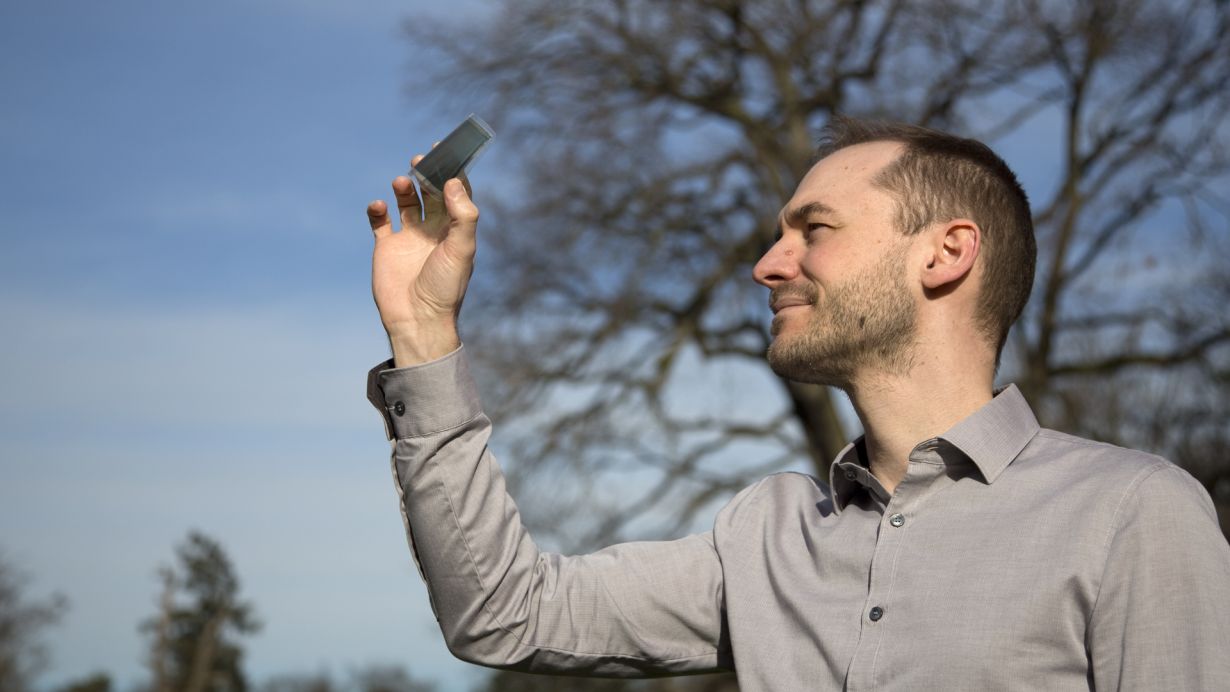Whether on glass surfaces of buildings, greenhouses or vehicles – semitransparent photovoltaics could significantly increase usable areas for a climate-friendly energy supply. In the SEMTRASOL research project, researchers at the Karlsruhe Institute of Technology (KIT) are developing solar cells with precisely adjustable absorption properties and high efficiency.
Organic solar cells are not only light in weight, non-toxic, independent of rare raw materials, and printable inexpensively on large areas. Compared to other photovoltaic technologies, they have another outstanding property: They can be manufactured as semitransparent solar panels, which opens up various new applications. While silicon photovoltaics are ubiquitously used today for generating energy, the benefits of organic solar cells so far have been greatly underestimated. “The big market breakthrough hence has not materialized so far,” says Dr. Christian Sprau from KIT’s Light Technology Institute. With his recently started research group and the SEMTRASOL research project, he intends to change that: “With new material concepts and the latest organic semiconductors, it is becoming increasingly possible to precisely control the absorption properties of organic solar cells and to achieve a high application-specific efficiency.” The result may be highly efficient but unobtrusive photovoltaics on glass fronts.
Use on Window Fronts or in Agriculture
Organic solar cells use carbon-based semiconductors, which are typically characterized by narrow-band absorption ranges. Thanks to the development of novel acceptors, i.e. the electron-accepting molecules in the light-absorbing layer in a solar cell, they can now achieve efficiencies of up to 20 percent in the laboratory. The variety of these new materials and the combination with targeted component design enable the absorption of incident light in precisely defined spectral ranges with a semitransparent solar cell. In this way, areas can be used in multiple ways in the future, explains Sprau: “In agrivoltaics, for example, only the wavelengths required for growth have to reach the plants, whereas they can be protected from other spectral components of the light and thus be prevented from drying out. The window front of a high-rise building, on the other hand, only has to let through the light that the human eye perceives as brightness. In both cases, high energy harvests can be achieved simultaneously with the unused portions of the sunlight.”
Booster for an Accelerated Energy Transition
According to the research team at KIT, a double use of space by photovoltaics will play an important role in enabling Germany and Europe to achieve climate neutrality in good time. The technological requirements have been met, and with SEMTRASOL, they will be combined now. “Specific goals are tailoring the transparency, a printable and scalable component architecture, the use of the latest materials, and environmentally friendly production,” explains Sprau. “It’s not trivial, but I’m convinced that semitransparent solar cells will be a natural part of our everyday lives in the not too distant future.”
About SEMTRASOL
The research project SEMTRASOL (SEMTRASOL stands for: Printable Semitransparent Organic Solar Cells for Photovoltaic Surfaces of the Future) is located at the Material Research Center for Energy Systems and the Light Technology Institute of KIT. The Vector Foundation is funding the research work as part of the junior research group program “MINT for the Environment” with one million euros for four years.
Read more: https://www.lti.kit.edu/english/opv.php
Details about the KIT Energy Center
In close partnership with society, KIT develops solutions for urgent challenges – from climate change, energy transition and sustainable use of natural resources to artificial intelligence, sovereignty and an aging population. As The University in the Helmholtz Association, KIT unites scientific excellence from insight to application-driven research under one roof – and is thus in a unique position to drive this transformation. As a University of Excellence, KIT offers its more than 10,000 employees and 22,800 students outstanding opportunities to shape a sustainable and resilient future. KIT – Science for Impact.

